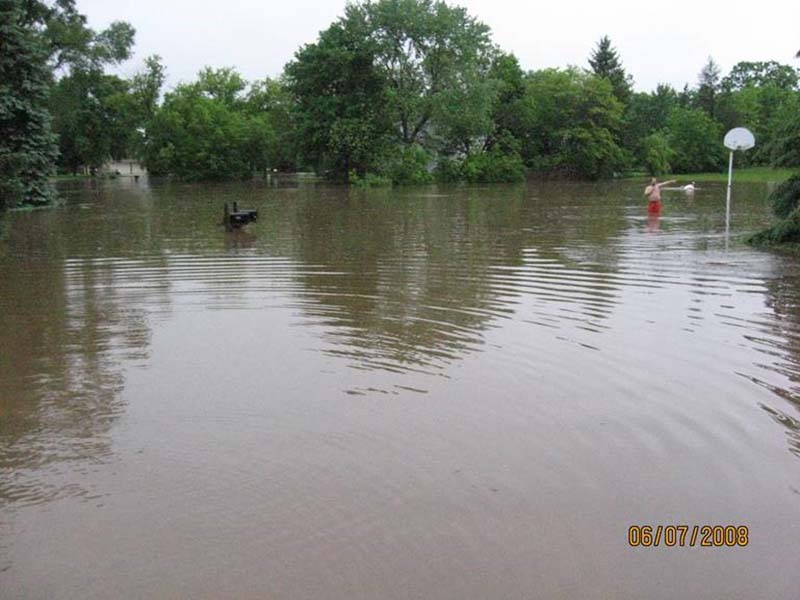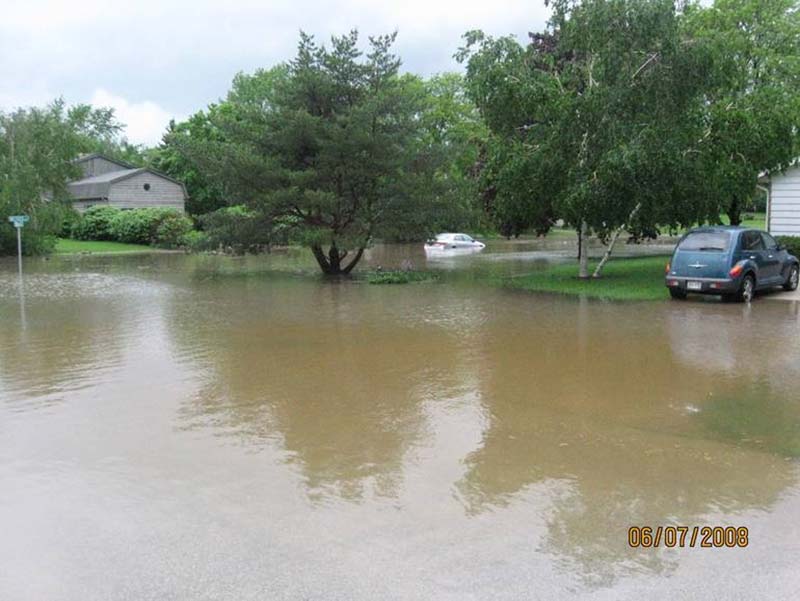Thomas Grisa is the director of public works for the City of Brookfield, Wisconsin.
Who are you/what is your role?
I am the director of public works for the City of Brookfield. I oversee engineering, street and highway maintenance, the city’s water utility, wastewater utility, and the solid waste/recycling program. Stormwater management is part of engineering.
What extreme storm events have you experienced in the city?
The City of Brookfield had severe flooding caused by 100-year storms in 1986, 1997, 1998, 2008, 2009, and 2010. The 1998 and 2008 events were really the most devastating ones. I started with the city in 1999, following the two 100-year storms in a row.
The 2008 event caused widespread power outages and impacted sump pumps at over 1,000 houses. The overflow into floor drains quickly overloaded the sanitary sewers. The flow to Brookfield’s wastewater treatment plant increased from an average of seven to a high of 58 million gallons per day, exceeding the 50 million gallon per day capacity. It also exceeded permit limits for treating wastewater during the storm.
No municipal system is designed to handle that amount of rain. The governor declared a state of emergency, making the city eligible for Federal Emergency Management Agency disaster relief funds.

What actions did you take?
In 2000, after the 1997 and 1998 floods, the city performed a massive study to determine the reasons for the flooding, how to address them, and to what extent do we want to address it. The issue is cost. We cannot design for every severe storm event that could ever happen. People wouldn’t be able to afford to live in the community.
We established standards based on what we expect the average rainfall to be. We are concerned that if that average rainfall is changing, then what we’ve designed for may be insufficient. Or if we see rainfall decreasing, as we do in other parts of the country, we may be building our facilities too big and wasting money. As design professionals, we want to understand what the data points are so that we are using the correct data. The trick is trying to predict what that future data will be.
We started massive improvements after the 2001 study was completed. We spent tens of millions of dollars throughout the 2000s. The 2008 rain event showed us that the areas where we did make improvements, did reasonably well, but also reinforced the need to continue to address the overall issue of flooding and justify the continued expenditure of funds.
Over time we were able to implement nearly all the recommended improvements. But those improvements were based on the old rainfall data. When the new data are published, we as a professional group of stormwater engineers will need to make a determination on using the new number or retaining the old number. If you retain the old number, you might build too small. If you design to the new number, which is based on less data, those designs cost the community more.
Ideally, you would design for the rainfall predicted for your area and that will be different in southeast Wisconsin and northwest Wisconsin.
If you go to our City of Brookfield website and search for flood information, you will see a whole myriad of resources on flooding I put it together after we had three severe (100-year) storms in a row.
What are some of the projects you have built to improve resilience?
We’ve used grants to buy properties in floodplains, especially in areas that are clearly in Federal Emergency Management Agency floodplains. We’ve also purchased outside of the official, unmapped, floodplain. We’ve modified our ordinance to restrict development in the floodplain. All the high ground, the easy places, in Brookfield has been developed. Now what’s left are the more difficult properties near areas that have environmental concerns, wetlands or floodplains.
We are trying to make certain we don’t create future problems. We require all new development to address the stormwater on site unless there is a regional facility that they can drain to, and we don’t have a lot of those. We’ve done a lot to upgrade storm sewers.
We could be anxious about whatever the new rainfall numbers might be, as it could make some of our current infrastructure undersized. That leads to questions such as how, or if, you address those capacity issues. How much flooding are you willing to tolerate versus how much it would cost to address it? That’s the balance.

What has been the community reaction to the flooding?
After the second storm I told the public it was a very severe storm instead of talking about it as a 100-year event. People don’t believe that two 100-year storms can occur back-to-back, but they can understand two severe storms occurring in consecutive years. When we call an event a 100-year storm, they don’t think of it as severe, they think of it as rare.
Accordingly, they may be unwilling to invest in improvements since in their minds the event is rare and unlikely to occur again. The general public better understood that storms that are severe are occurring repeatedly, better than trying to understand the statistics of a rare event occurring repeatedly.
This leads into what I like to call the “Hydro-illogic cycle.” It rains really hard and causes flooding. We hire consultants to study the problem and present solutions to the council. This takes time. If it hasn’t rained a lot during that time period, then people put the plans on the shelf and never implement the solutions since they are so costly.
The next time it rains, you repeat the cycle. We had two severe flooding events in a row, the second of which broke the cycle. We never got to the part where it usually breaks down and the council was willing to fund the improvements.
We haven’t had major flooding since the 2010 event. We have been fortunate. We’ve done ninety to ninety-five percent of the improvements in the early 2000 study and there are not a lot of areas to look at for improvements now. There will be a whole new discussion if we do get another massive flooding event here in Brookfield.
Do you have any advice for other communities dealing with flood issues?
We pay for the decisions that were made years ago. We need to do the best we can with our given infrastructure and make appropriate improvements based on the best data we can find. Massive events can’t be designed for without overwhelming cost. Water has a memory; water will go where it used to go before humans modified the landscape. That will help us identify potential problem areas.
Learn More
- City of Brookfield flood information
- Rainfall Pattern Over Southeastern Wisconsin, 26-Hour Storm on June 20-21, 1997 (pdf)
- Rainfall Pattern Over Southeastern Wisconsin, 24-Hour Period on August 6, 1998 (pdf)
The views and opinions expressed in this interview are those of the authors and do not represent official policy or position of the University of Wisconsin-Madison or the Wisconsin Initiative on Climate Change Impacts.
For More Information
Thomas M. Grisa, P.E. F. ASCE
Director of Public Works
City of Brookfield
2000 N. Calhoun Road
Brookfield, WI 53005
(262) 796-6644